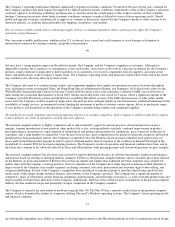Apple 2003 Annual Report Download - page 43
Download and view the complete annual report
Please find page 43 of the 2003 Apple annual report below. You can navigate through the pages in the report by either clicking on the pages listed below, or by using the keyword search tool below to find specific information within the annual report.
performed a sensitivity analysis to determine the impact that a change in interest rates would have on the value of the investment portfolio
assuming a 100 basis point parallel shift in the yield curve. Based on investment positions as of September 27, 2003, a hypothetical 100 basis
point increase in interest rates across all maturities would result in a $12.9 million decline in the fair market value of the portfolio. As of
September 28, 2002, a similar 100 basis point shift in the yield curve would have resulted in a $37.7 million decline in fair value. Such losses
would only be realized if the Company sold the investments prior to maturity. Except in instances noted above, the Company's policy is to hold
investments to maturity.
The Company sometimes enters into interest rate derivative transactions, including interest rate swaps, collars, and floors, with financial
institutions in order to better match the Company's floating-rate interest income on its cash equivalents and short-term investments with its
fixed-rate interest expense on its debt, and/or to diversify a portion of the Company's exposure away from fluctuations in short-term U.S.
interest rates. The Company may also enter into interest rate contracts that are intended to reduce the cost of the interest rate risk management
program. The Company entered into no interest rate asset swaps during 2003 or 2002 and had no open interest rate asset swaps at
September 27, 2003.
In prior years, the Company had entered into interest rate debt swaps with financial institutions. The interest rate debt swaps, which qualified as
accounting hedges, generally required the Company to pay a floating interest rate based on the three- or six-month U.S. dollar LIBOR and
receive a fixed rate of interest without exchanges of the underlying notional amounts. These swaps effectively converted the Company's fixed-
rate 10-year debt to floating-rate debt and convert a portion of the floating rate investments to fixed rate. Due to prevailing market interest
rates, during 2002 the Company entered into and then subsequently closed out debt swap positions realizing a gain of $6 million. During 2001
the Company closed out all of its then existing debt swap positions realizing a gain of $17 million. Both the gains in 2002 and 2001 were
deferred, recognized in long-term debt and are being amortized to other income and expense over the remaining life of the debt.
Foreign Currency Risk
Overall, the Company is a net receiver of currencies other than the U.S. dollar and, as such, generally benefits from a weaker dollar and is
adversely affected by a stronger dollar relative to major currencies worldwide. Accordingly, changes in exchange rates, and in particular a
strengthening of the U.S. dollar, may negatively affect the Company's net sales and gross margins as expressed in U.S. dollars. There is also a
risk that the Company will have to adjust local currency product pricing within the time frame of our hedged positions due to competitive
pressures when there has been significant volatility in foreign currency exchange rates.
The Company enters into foreign currency forward and option contracts with financial institutions primarily to protect against foreign exchange
risks associated with existing assets and liabilities, certain firmly committed transactions, and probable but not firmly committed transactions.
Generally, the Company's practice is to hedge a majority of its existing material foreign exchange transaction exposures. However, the
Company may not hedge certain foreign exchange transaction exposures due to immateriality, prohibitive economic cost of hedging particular
exposures, and limited availability of appropriate hedging instruments. The Company also enters into foreign currency forward and option
contracts to offset the foreign exchange gains and losses generated by the re-
measurement of certain recorded assets and liabilities denominated
in non-functional currencies of its foreign subsidiaries.
In order to provide a meaningful assessment of the foreign currency risk associated with certain of the Company's foreign currency derivative
positions, the Company performed a sensitivity analysis using a value-at-risk (VAR) model to assess the potential impact of fluctuations in
exchange rates. The VAR model consisted of using a Monte Carlo simulation to generate 3000 random market price paths. The VAR is the
maximum expected loss in fair value, for a given confidence interval, to the Company's foreign
53
exchange portfolio due to adverse movements in rates. The VAR model is not intended to represent actual losses but is used as a risk estimation
and management tool. The model assumes normal market conditions. Forecasted transactions, firm commitments, and assets and liabilities
denominated in foreign currencies were excluded from the model. Based on the results of the model, the Company estimates with 95%
confidence a maximum one-day loss in fair value of $7.5 million as of September 27, 2003 compared to a maximum one-day loss of
$3.8 million as of September 28, 2002. Because the Company uses foreign currency instruments for hedging purposes, losses incurred on those
instruments are generally offset by increases in the fair value of the underlying exposures.
Actual gains and losses in the future associated with the Company's investment portfolio and derivative positions may differ materially from
the sensitivity analyses performed as of September 27, 2003 due to the inherent limitations associated with predicting the changes in the timing
and amount of interest rates, foreign currency exchanges rates, and the Company's actual exposures and positions.
54
Item 8. Financial Statements and Supplementary Data
























